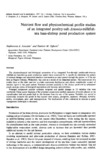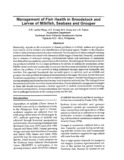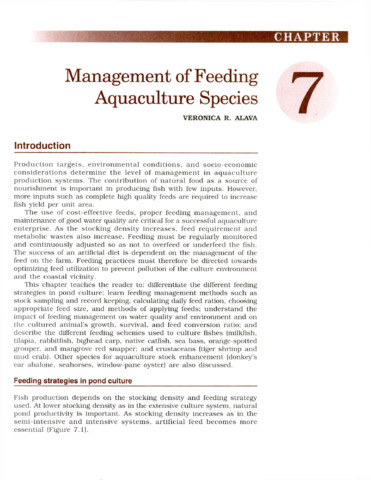Nutrient flow and physicochemical profile studies of an integrated poultry-salt-Artemia-milkfish-sea bass-shrimp pond production system
- Global styles
- MLA
- Vancouver
- Elsevier - Harvard
- APA
- Help

View/
Date
1987Page views
6,391ASFA keyword
AGROVOC keyword
Taxonomic term
Metadata
Show full item record
Share
Abstract
The physicochemical and biological parameters of an integrated flow-through poultry-salt-Artemia-milkfish-sea bass-shrimp pond production system were monitored for 6 months to determine the pattern of nutrient changes and associated plankton communities as water passed through the system. A 20 ha salt farm in Negros Oriental, Philippines, was used as a model of the integrated system. The construction of a poultry farm at the inlet reservoir provides continuous fertilization and allows considerable control of nutrient inputs to the pond system. Nutrients increase markedly in the chicken pond and in subsequent ponds undergo cycles of biological assimilation and bacterial mineralization.
Principal component analysis ordinates temporal and spatial changes in 33 variables that were monitored. Using scatter diagrams of the principal components enabled separation of ponds adjacent to the crystallization bed and ponds high in fish biomass from the rest of the system. Variables that served to numerically delineate the ponds in this manner were salinity, phosphate, ammonia, alkalinity, turbidity, acidity, microplants, pico- and nannoplankton. The implications of this ordination in relation to pond management techniques is discussed.
Suggested Citation
Jumalon, N. A., & Ogburn, D. M. (1987). Nutrient flow and physicochemical profile studies of an integrated poultry-salt-Artemia-milkfish-sea bass-shrimp pond production system. In P. Sorgeloos, D. A. Bengtson, W. Decleir, & E. Jaspers (Eds.), Artemia Research and its Applications (Vol. 3. Ecology, Culturing, Use in Aquaculture, pp. 239-251). Wetteren, Belgium: Universal Press.
Type
Conference paperCollections
- Conference Proceedings [299]
Related items
Showing items related by title, author, creator and subject.
-
Management of fish health in broodstock and larvae of milkfish, sea bass and grouper
Lavilla-Pitogo, Celia R.; Emata, Arnil C.; Duray, Marietta N.; Toledo, J. D. (The Oceanic Institute, 1996)Historically, reports on the occurrence of disease problems in milkfish, seabass and grouper were mainly on the isolation and identification of etiological agents. Studies on the tolereance of fish to chemotherapeutants ... -
Management of feeding aquaculture species
Alava, Veronica R. (Aquaculture Department, Southeast Asian Fisheries Development Center, 2002)This chapter teaches the reader to: differentiate the different feeding strategies in pond culture; learn feeding management methods such as stock sampling and record keeping, calculating daily feed ration, choosing ... -
Ration reduction, integrated multitrophic aquaculture (milkfish-seaweed-sea cucumber) and value-added products to improve incomes and reduce the ecological footprint of milkfish culture in the Philippines
de Jesus-Ayson, Evelyn Grace T.; Borski, Russel J. (AquaFish Collaborative Research Support Program, Oregon State University, 2012)In the Philippines, cage culture of milkfish in marine environments is increasing. The practice uses high stocking densities, with significantly greater inputs of artificial feeds which more often than not, have led to ...





